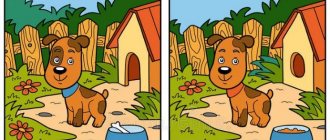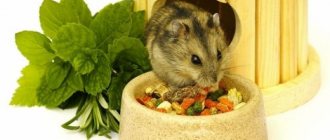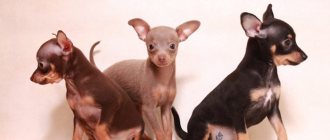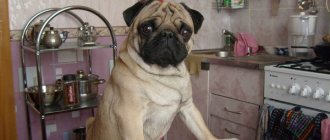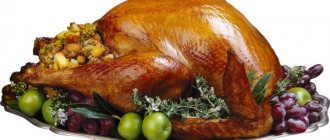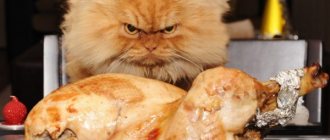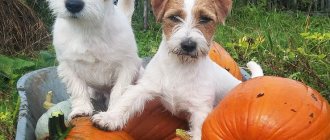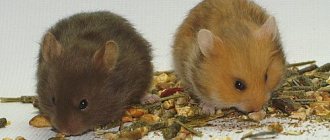Predisposition to disease
Despite their grace and miniature size, toy terriers are naturally endowed with strong immunity and vitality. However, the disease can turn a baby into an emaciated dog in two days.
Toy Terriers are predisposed to some typical diseases due to the characteristics of their physiology and immune system:
- problems with the musculoskeletal system, which is facilitated by the active and inquisitive nature of the Toychik and the genetics of the breed;
- tartar, periodontal disease, early tooth loss;
- tendency to allergic reactions to food, insect bites, pollen;
- digestive problems – gastritis, pancreatitis;
- hydrocephalus, eye diseases.
Most of these diseases can be avoided if you properly plan your dog's diet.
How to switch a dog from one type of food to another?
Like all miniature breeds, toy terriers have very delicate digestion, so “jumping” from one type of food to another is unacceptable. Also, you should not suddenly change the brand of dry food. The transfer should be carried out gradually, over the course of a week.
Scheme for changing food for a toy terrier
When a puppy moves from breeder to owner, the latter must adhere to the same type of feeding. Until six to eight months, it is not advisable to switch your pet to another food unless absolutely necessary, for example, due to health problems. If the owner wants to change natural food to industrial food or vice versa, he must proceed as follows:
- Day one – nine parts of the usual food and one part of the new food are placed in the dog’s bowl.
- Second day - the bowl contains eight parts of old food and two parts of new food.
- The third day is a combination of 70% of the old diet and 30% and then the same.
A sudden change in diet can lead to disruption of the dog’s gastrointestinal tract
The same scheme applies if the owner changes one brand of dry food to another. An exception is veterinary dietary food; you can switch your dog to it in one day.
Rules for creating a diet
The health of a miniature pet largely depends on a balanced diet. The menu should contain sufficient quantities of all useful substances: proteins, fats, carbohydrates and vitamins.
Components of the diet for toy terriers:
- 30-35% – animal proteins (meat or fish);
- 30% – cereal products;
- 20-25% – vegetables and fruits;
- 10-15% – dairy products.
For dogs of this breed, raw or scalded beef, veal, and white sea fish are useful. Offal (heart, liver, tripe), chicken and eggs are also included in the menu.
The daily portion of meat and fish products is calculated based on 50-80 grams per 1 kg of pet weight.
It is useful to feed a toy terrier buckwheat, rice, and oatmeal at the rate of 30 grams per 1 kg of weight.
They add fresh or boiled zucchini, cucumbers, bell peppers, carrots - 50 grams per 1 kg of body weight. Tomatoes can cause allergies, beets are known as a laxative, cabbage causes flatulence, so these products are given to dogs in small quantities.
To strengthen the bones and joints of toy terriers, low-fat kefir, cottage cheese, fermented baked milk (50 grams per 1 kg of weight) are useful. Only puppies are fed whole milk; adult toy terriers make do with fermented milk products.
There should always be a sufficient amount of fresh, unboiled water in the dog’s access area. The bowl of food is set out for twenty minutes. If after a while the food remains uneaten, it is removed, and the next time the dose is reduced. If the dog licks the bowl to the bottom, looks into the owner’s face, and asks for more, the amount of food in the serving is increased.
Approximate daily diet for an adult toy terrier:
| Times of Day | Option I | Option II | Option III |
| Morning | Stewed beets with chopped beef | Cottage cheese with kefir or fermented baked milk | Oatmeal with boiled chicken heart or gizzards |
| Evening | Beef liver rice | Hake or pollock with cucumbers or carrots | Boiled chicken with buckwheat |
What to feed your toy terrier. Menu for dogs
Small Toy Terrier dogs quickly won the hearts of women and children in big cities and beyond.
Due to their cute appearance and smart, playful nature, miniature dogs bring a lot of joy and fun to the house. But buying a toy terrier puppy is only the beginning of spending money, time and nerves.
Dogs of this breed are very demanding of themselves and their health, which, first of all, lies in nutrition.
Remember: your dog's health is in your hands!
When wondering what to feed your toy terrier, you also need to remember that your baby is a dog. This means that feeding a toy should also be based on the general rules of feeding dogs. I suggest you consider them first.
Dog Nutrition Basics
Products. Don't feed dogs food from your table. A separate menu must be drawn up for your pet, and the only way it differs from the average person’s menu is that it must be absolutely healthy.
There's so much in these words, right? These are products such as: sea fish, lean meat, low-fat cottage cheese, kefir, fermented baked milk, chicken and quail egg yolks, vegetables, fruits, honey, seaweed, porridge, etc. And no sausages, fried, smoked or canned food.
We have already looked at all these products in more detail in one of the previous articles about the rules of feeding dogs. Therefore, I don’t want to repeat myself, but I invite you to read it here.
Frankly speaking, after observing the health of my dog, I came to the conclusion that it was time for me to join her menu. The products that stores offer us are far from healthy products. Sausages, sauces, canned food and even bread do not bring proper benefits to the human body and are harmful to some extent. Therefore, my dog and I eat the same foods, but from her menu.
Feeding frequency. Despite the tragic, pleading, soul-tearing look of your dog, you are obliged to feed it on schedule. An adult dog needs to be fed twice a day - morning and evening, preferably after a walk.
And don’t give in to her antics and pleas. Otherwise, you risk giving your dog obesity, various diseases and overindulgence.
How many times a day you need to feed your dog depending on its age, read the article about approximate feeding patterns that were written earlier in the blog.
Balance in dog nutrition. Many dog owners feed their pets from their table with the expectation that the dog thus receives the necessary nutritional components. Like, everything that the body needs will be taken, and everything that is not needed will go away.
But, everything that is not needed does not always go away, but accumulates in the body and, as a result, we observe allergies and other diseases.
Therefore, it is better to create a balance of food for dogs according to their menu, which does not contain large amounts of salt, sugar, spices, preservatives, fatty, fried, smoked, etc.
To get even a little closer to ideal feeding for dogs, remember how wolves feed. Firstly: they eat herbivores and first of all tear apart the stomach of the victim in order to get semi-digested grass and grains.
Let's conclude: we feed dogs cereals (boiled or scalded in boiling water). Next, the wolves eat the meat of the victim and ATTENTION: they leave bones! The meat of wild herbivorous animals is not fatty, since these animals are in constant motion (remember the field hare, roe deer, bird or wild boar).
Therefore, a domestic fat, motionless pig will only harm the dog.
Don't give bones to dogs!
To understand to what extent a particular pet is an omnivore, a herbivore or a predator, in order to create the right menu for it, you should analyze its teeth. Animals such as a cow, horse, goat, rabbit, hamster have mainly teeth that help them pull out and grind grass, vegetables, and grains.
They have no fangs. This means there is no need for the goat to eat meat. Cats and dogs have teeth designed to tear out pieces of meat. This means that these pets should be given mainly fish and meat dishes for breakfast and dinner.
And only a small percentage of cereals, fruits, vegetables to maintain the stomach in the required condition.
And here’s a puzzle for you for your leisure time: what percentage of meat should be in a person’s daily diet, based on the number of teeth special for this product? After all, a person has fangs, incisors, and teeth for grinding grass and grains. Man is considered an omnivore. How many percent are we predators and how many are herbivores? Here, nature itself tells us the ideal balance of nutrition.
Many people write about dry food, where the nutritional balance is ideally selected for almost every breed of dog. I am a supporter of natural products, so, with your permission, I will not bother writing about dry food. For this purpose I will probably make a separate article.
So, we have covered the basics of dog nutrition. Now let’s return to the question – what to feed the toy terrier. In this case, everyone is interested in a clear menu with prescribed products. I don't have a toy terrier, but I also have a small dog. And I, based on the menu of my favorite, will try to create a menu for the toy terrier. And of course, I will take into account all the necessary characteristics of the breed.
Menu for a toy terrier for a week
Monday: Morning - beef (cut into small pieces, or make minced meat) + rice; Lunch - homemade cottage cheese (you can add honey or egg yolk, or wheat germ oil); Evening – sea fish (salmon, pollock, etc.) + grated carrots.
Tuesday: Morning – beef + oatmeal; Lunch – kefir or fermented baked milk; Evening – sea fish + seaweed (clean);
Wednesday: Morning – beef liver + buckwheat; Lunch – boiled beets + carrots + zucchini; Evening – sea fish + sauerkraut.
Thursday: Morning – beef + rice; Lunch – homemade cottage cheese; Evening – sea fish + grated carrots.
Friday: Morning – beef + oatmeal; Lunch – kefir or fermented baked milk; Evening – sea fish + seaweed.
Saturday: Morning – beef liver + buckwheat; Lunch – vegetables; Evening – sea fish + sauerkraut.
Sunday: Morning – beef + rice; Lunch – homemade cottage cheese; Evening – sea fish + herbs (parsley, dill).
From the above products, you can create a menu for puppies, adding the number of feedings per day from fermented milk products. The fact is that when babies grow, they need calcium for the skeletal system, and of course protein.
Some recommendations from personal experience
1. Meat, fish, cottage cheese can and should even be frozen in portions. This way, it will be convenient for you to always keep the necessary products at hand, and also rid them of bacteria.
2. Porridge can be lightly salted, using sea salt.
3. I buy fortified children’s kefir for my baby and recommend it to you.
4. You can find low-fat cottage cheese, but it will not be homemade. I preferred homemade, even if it was greasy. It's healthier than store-bought. I give it a little at a time so that the fat content doesn’t hit the baby’s liver.
5. Feeding your dog beets is very healthy. Don't be scared when you see her peeing burgundy urine. This is fine.
6. Do not increase portions more than necessary.
7. Many experts recommend giving dogs vitamins. My dog grew up in excellent strong shape even without them. You can try treating yours with vitamins. But, it is better not to accustom her body to ready-made artificial vitamins, let her suck them out of natural products. That's why we feed them.
Feeding, no matter how correct, will not save your dog from diseases or allergies if you initially bought a puppy prone to diseases. Do not buy dogs at low prices, be sure to analyze the health status of their parents, and also check all the necessary documents that are provided to you along with the puppy.
Portion and proportions
Source: https://sobakan.com/chem-kormit-toj-terera/
Prohibited Products
The Toy Terrier's diet does not include fatty, fried, smoked and canned foods. Pork (especially lard), minced meat, river fish, and bones are prohibited. Adult dogs should not be given milk or raw egg whites. Toy terriers are not fed butter, rich sour cream, or cream. The toy's body has difficulty digesting starch, so potatoes are also excluded from the diet.
Legumes, barley and pearl barley porridge are poorly digestible by the digestive system of this breed. Do not feed the Russian Toy Terrier baked goods (especially fresh baked goods), pasta, or sweets. Food with spices, preservatives, dyes, and flavorings can cause poisoning. Due to a tendency to allergies, the dog is not given probable allergens - citrus fruits, soy, as well as grapes and nuts.
For older toy terriers
The diet of older dogs is compiled taking into account all the changes that occur in the body after 8-10 years of life. If your pet has excess weight, shortness of breath, age-related changes in the joints, or decreased activity, it’s time to take care of adjusting the menu.
As a dog ages, it spends less energy on walks and its metabolism slows down. Therefore, first of all, reduce the proportion of fats, especially of animal origin. Now the dog's food should be low-calorie.
In older dogs, the need for protein decreases. Large amounts of meat now have an adverse effect on the kidneys. Therefore, part of the meat is replaced with fish and fermented milk products.
If your pet is overweight, reduce the proportion of cereals in favor of vegetables. To replenish the need for vitamins, carrots, broccoli, and zucchini are given raw.
Constipation is a common problem in older dogs. To avoid this, add a little wheat bran to the feed.
Due to dental diseases typical for the breed, food for older Toy Terriers is ground up. The size of the pieces is made so that the pet can easily swallow them without chewing.
Industrial feed
If the owner of a toy terrier is a busy person, or he wants to be sure that his pet receives all the substances necessary for health with food, then choosing ready-made food will be the right decision. All the proteins, carbohydrates, fats, vitamins, microelements, enzymes, and probiotics that an animal needs are contained in premium and super-premium food. Food and canned food from the Acana, Orijen, Arden, Pro Plan, Royal Canin, and Hill's brands have proven themselves well. The daily food intake depending on the weight of the animal is indicated on the packaging. When purchasing dry or wet food, choose special lines for miniature breeds.
Industrial food is introduced into the puppy’s menu in the same way as natural products. Dry granules for babies are soaked in warm water for the first two months.
Choosing a place to eat and dishes
Each owner solves this issue in his own way. When organizing a “dining room”, you need to consider several points.
The feeding area should be:
- light;
- secluded (a dog having lunch should not disturb the household and they should not disturb it);
- easily accessible for both the animal and the owner;
- equipped with a easily washable surface;
In small apartments, the puppy’s feeding place is determined in the kitchen. In this case, the doors are left constantly open, this will provide free access to a bowl of food and water. If the area allows and the dog has its own “room”, then the feeding place will be equipped in it. The distance from the resting place to the bowl should be significant.
When choosing dishes, you should take into account that the full amount of food should occupy only half the volume of the bowl. The dishes should not be allowed to:
- moved;
- capsized;
- jumped up while eating food.
The material from which the bowl is made must be food-grade, high-quality, and durable. Bowls for water and food should be nearby, but not interfere with each other. For this breed there is no need to set up a feeding area at higher elevations. If the owner intends to feed the puppy “from the table,” there should still be room for a bowl. Initially, it is necessary to accustom the dog to it. In the future, this will make it possible to understand that the dog is hungry (when approaching the bowl and sniffing).
Vitamin and mineral supplements
When eating homemade foods, the dog additionally requires complex vitamin and mineral supplements.
The composition of the complex for this breed should contain:
- carotene – to maintain eye health;
- B vitamins – to strengthen the nervous and cardiovascular systems;
- calcium, phosphorus, iodine, iron, zinc - for strengthening bones and joints, proper metabolism, for a thick and smooth coat.
The proportions of ingredients in vitamin complexes vary depending on the purpose:
- for growing puppies and juniors;
- for pregnancy and lactation of bitches;
- for older dogs of small breeds;
- to improve the condition of the coat;
- to strengthen bones and joints.
Vitamin and mineral complexes are chosen for your pet on the advice of a veterinarian, taking into account the developmental characteristics and health status.
Vitamins and supplements
The condition of the skin, fur, mucous membranes and teeth is an indicator of the dog’s health. If the puppy is playful, energetic, and has constantly formed fecal masses, then there is no need for vitamins and supplements.
If the slightest pathology is detected, you should consult a veterinarian. A vitamin preparation is a medicine and should be prescribed by a specialist based on the results of the examination and tests performed.
Reviews
Andrey, Kurgan
“My girlfriend recently bought a toy terrier puppy. They didn’t give him anything harmful, they fed him 4 or 5 times a day, but by the fifth month he looked like a barrel with thin legs. In addition, Joy often had stomach pain and diarrhea. I think the food portions were too large and we overfed the puppy. They put him on a diet, now his stomach doesn’t stick out so much, and the diarrhea has stopped.”
Yana, Krasnodar
“My toe is 1.5 years old. I fed her canned food in the morning and Akana dry food in the evening. She recently stopped eating dry food and started vomiting yellow foam frequently. While we were making an appointment with the doctor, I was waiting for the appointment date, switched the dog to natural, and she came to life! I started playing again and enjoying life.”
Arina, Sverdlovsk region
“Toy terrier, 2 years old. I don’t cook oatmeal or buckwheat for him, but only steam it with water or broth. Milk, no matter how much the dog likes it, is contraindicated. But kefir and cottage cheese are very useful. I add scalded or boiled (not raw or boiled, but just brought to a boil) lean meat or fish to the porridge. When Toy started having bad breath, it was most likely the beginning of problems with the gastrointestinal tract. I started giving him chicken breast, and added fiber to the porridge - carrots, pumpkin, zucchini. The smell is gone. From the first days I give the dog calcium and vitamins. He is active, cocky and very funny."
What to feed a toy terrier: dietary features
Toy terriers are one of the dog breeds that are considered puppies, even if the dog is already an adult. Small, smooth-haired dogs have fascinated, above all, women all over the world.
A toy terrier can be carried in a bag (it is important to remember that the bag for carrying a pet must be designed for this purpose) to various events, or taken with you on a visit or to a cafe. Babies love the attention of their owners more than anything else in life and are happy to be near them all the time.
The popularity of the breed in the world is great, but small dogs require an even more responsible approach on the part of the owner. Improper feeding can lead to problems with the stomach and intestines. Toy terriers do not complain about their health if they follow the correct diet and walk in clothes in the cold season.
Advice! If an adult dog looks like a puppy, then you cannot feed it based on the number of feedings of puppies. An adult Toy Terrier should eat 2 times a day, like any breed of dog.
Despite its size and fragile build, the basis of the diet for this breed is meat . Toy Terriers are incredibly active dogs that expend enormous amounts of energy throughout the day, making them constantly ready to eat more.
But you should not overfeed your pet, as obesity will sharply reduce life expectancy. It is important to balance food in terms of protein, carbohydrates and fats.
Important! Meat in the diet of a small predator should be from 40 to 50%, cereals (cereals) - from 20 to 30%, vegetables - 15-25%, fruits - 2-5%.
The standard for toy terriers appeared at the end of the 20th century, according to which the dog’s weight does not exceed 3 kg, and its height reaches 20–28 cm .
If the dog is shorter than the declared height, then its weight should not exceed 1.5–2 kg. Portions for adult pets are weighed on an electronic kitchen scale, which will be very helpful in determining the weight of a portion.
For every kilogram of animal weight there should be 65–80 grams of food.
What is the best way to feed a toy terrier?
There are two food options for the toy terrier - natural or dry . Breeders have varied opinions about the benefits of this or that type of feeding; there is no consensus here.
But it is important to remember that if in the first months the puppy was on natural food, then accustoming him to dry food should be gradual. Over the course of a month, you add a little dry food to the diet, replacing one natural feeding completely with dry food.
A smooth transition is important for the dog's digestive system.
Important! Many veterinarians are of the opinion that it is impossible to combine dry and natural food. If the dog eats only dry food, then there is no need to give it additional fruit or meat.
Natural feeding provides additional vitamins, which are prescribed by a veterinarian based on the results of the examination.
Adult dogs, starting from 9 months, are fed 2 times a day. It is best to do this after morning and evening walks.
If the pet goes to the litter box, then you can safely feed it at any time in the morning or evening, the main thing is not to feed it too late in the morning - the toy terrier should not go hungry. The serving size is determined by the weight of the animal - about 80 grams of food per 1 kg of weight .
Important! Additionally, natural food is not salted or sugar is added.
Natural feeding can be varied as desired: give meat and porridge in the morning, vegetables or cottage cheese in the evening, the next day you can replace dairy foods with fish. The food of a small pet should be as healthy and complete as possible.
Many owners note that their pets’ diet prompted them to change their own eating pattern. After all, in fact, the nutrition of a toy terrier is what almost every trainer in the gym will offer to switch to a dietary and healthy diet.
Food must be fresh and prepared daily - you cannot feed your dogs week-old porridge .
Features of the diet for small breeds
Toy terriers, despite their small weight, can eat raw meat, which they do with great pleasure . But experienced owners do not simply give their kids raw purchased beef. The meat is cut into portions and placed in the freezer, which is necessary to destroy parasites that may be in the meat.
In addition, before feeding the meat to the dog, it is not only defrosted, but also scalded with boiling water. Some owners cook the meat in boiling unsalted water for 5 minutes.
You can do the same with fish and cottage cheese - divide into portions and put in the freezer, and give to the animal after defrosting. By-products are good for dogs; they are not frozen, but doused with boiling water or boiled for several minutes.
No spices are added to the porridges given to toy terriers, nor to stewed vegetables. An exception is that sea salt on the tip of a teaspoon is added to the porridge, but this is not done often.
If your dog eats yogurt, it should not contain dyes. Cottage cheese for toy terriers is often made from children's cottage cheese. You can mix meat with porridge (1/3 porridge and 2/3 meat) if your pet does not want to eat porridge in its pure form.
Advice! A dog that eats healthy food has a cheerful appearance, its coat is glossy and shiny, its eyes are not watery, its nose is moist, its breath is clear, and there is no smell from its mouth. If you see negative changes in your dog's appearance, contact your veterinarian.
Dry food for toy terriers – which is best?
Veterinarians are of the opinion that the main thing in choosing dry food should be the selection of food specifically for small breed dogs . These foods contain the entire range of vitamins a baby needs. It is worth choosing premium brands. Trusted manufacturers of food for toy terriers are the following companies: , etc.
Selecting the right food consists of choosing a product that contains several types of grains, 2-3 types of meat (chicken and beef), vitamins, dry vegetables and fruits . All this will provide the toy terrier with the energy he needs. Breeders do not recommend alternating natural feeding and dry food.
If the dog eats only dry food, it can sometimes be given fermented milk products (cottage cheese, kefir).
Important! Dry food should not contain soy, dyes, flavor enhancers, corn grits, or grains (wheat).
What you can and cannot feed
Mandatory components in the toy terrier's diet will be beef and chicken. You can also note the following products allowed for consumption :
- lamb, offal;
- cottage cheese, kefir;
- natural yogurt (without dyes and sugar);
- rice, buckwheat, rolled oats;
- fish, exclusively sea fish - salmon, pollock;
- zucchini, carrots, beets, tomatoes;
- seaweed;
- dill, parsley;
- chicken yolk (be sure to cook!);
- honey (no more than 1 time per week);
- vegetable or olive oil (1-2 drops 2 times a week);
- bananas, apples.
Generally speaking, the toy terrier is prohibited from any food from the master's table that contains sugar and salt in excess . The list can be supplemented with the following products, feeding which will not only cause allergies in the dog, but will also lead to serious illnesses:
- sausages, fried meat, smoked meats;
- spicy foods, seasonings, ketchup, sauces and mayonnaise;
- chips, crackers, cookies;
- chocolate, sweets;
- pasta, bread;
- pork and any fatty meat;
- raw offal and raw fish;
- potatoes and legumes;
- a raw egg.
It is worth noting that small breeds require careful and special treatment both in nutrition and handling. Toy terriers are practically dependent on their owner on a psychological level - they love attention very much, are afraid of large objects, loud noise . Therefore, it is important to provide the baby with a carefree existence.
Advice! Do not feed your toy terrier food from the table, no matter how much he whines and dances in front of you. This is fraught with health problems.
Monitor the dog’s well-being and general condition, do not keep it hungry. If your pet eats the portion too quickly, increase it by 10-15 grams, which will allow you to understand whether he needs additional nutrition.
But it is important to remember the ratio of height and weight; the toy terrier should not be swollen or have a bloated belly . The dog should always be graceful and active. If your pet does not eat for more than a day, you must take the animal to the veterinarian. A healthy and nutritious diet will give your dog a life expectancy of 13-18 years .
video about the nutrition of toy terriers:
4 Comments
Source: https://vashkinolog.com/porody/malenkie/toj-terer/toj-korm.html

